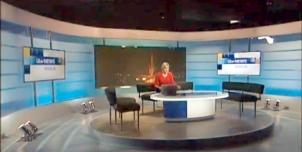Full Freeview on the Sudbury (Suffolk, England) transmitter
| Google Streetview | Google map | Bing map | Google Earth | 52.005,0.786 or 52°0'17"N 0°47'8"E | CO10 5NG |
The symbol shows the location of the Sudbury (Suffolk, England) transmitter which serves 440,000 homes. The bright green areas shown where the signal from this transmitter is strong, dark green areas are poorer signals. Those parts shown in yellow may have interference on the same frequency from other masts.
_______
Digital television services are broadcast on a multiplexes (or Mux) where many stations occupy a single broadcast frequency, as shown below.
64QAM 8K 3/4 27.1Mb/s DVB-T MPEG2
H/V: aerial position (horizontal or vertical)
The Sudbury (Suffolk, England) mast is a public service broadcasting (PSB) transmitter, it does not provide these commercial (COM) channels: .
If you want to watch these channels, your aerial must point to one of the 80 Full service Freeview transmitters. For more information see the will there ever be more services on the Freeview Light transmitters? page.
Which Freeview channels does the Sudbury transmitter broadcast?
If you have any kind of Freeview fault, follow this Freeview reset procedure first.Digital television services are broadcast on a multiplexes (or Mux) where many stations occupy a single broadcast frequency, as shown below.
64QAM 8K 3/4 27.1Mb/s DVB-T MPEG2
H/V: aerial position (horizontal or vertical)
The Sudbury (Suffolk, England) mast is a public service broadcasting (PSB) transmitter, it does not provide these commercial (COM) channels: .
If you want to watch these channels, your aerial must point to one of the 80 Full service Freeview transmitters. For more information see the will there ever be more services on the Freeview Light transmitters? page.
Which BBC and ITV regional news can I watch from the Sudbury transmitter?

BBC Look East (East) 0.8m homes 3.2%
from Norwich NR2 1BH, 77km north-northeast (24°)
to BBC East region - 27 masts.
70% of BBC East (East) and BBC East (West) is shared output

ITV Anglia News 0.8m homes 3.2%
from NORWICH NR1 3JG, 78km north-northeast (24°)
to ITV Anglia (East) region - 26 masts.
All of lunch, weekend and 80% evening news is shared with Anglia (West)
Are there any self-help relays?
| Felixstowe West | Transposer | 1000 homes +1000 or more homes due to expansion of affected area? | |
| Witham | Transposer | 14 km NE Chelmsford. | 118 homes |
How will the Sudbury (Suffolk, England) transmission frequencies change over time?
| 1984-97 | 1997-98 | 1998-2011 | 2011-13 | 1 Aug 2018 | |||||
| B E T | B E T | B E T | E T | K T | |||||
| C29 | SDN | ||||||||
| C31 | ArqA | ||||||||
| C35 | C5waves | C5waves | |||||||
| C37 | ArqB | ||||||||
| C41 | ITVwaves | ITVwaves | ITVwaves | D3+4 | D3+4 | ||||
| C44 | BBC2waves | BBC2waves | BBC2waves | BBCA | BBCA | ||||
| C47 | C4waves | C4waves | C4waves | BBCB | BBCB | ||||
| C51tv_off | BBC1waves | BBC1waves | BBC1waves | ||||||
| C56tv_off | ArqB | ||||||||
| C58tv_off | SDN | ||||||||
| C60tv_off | -ArqA |
tv_off Being removed from Freeview (for 5G use) after November 2020 / June 2022 - more
Table shows multiplexes names see this article;
green background for transmission frequencies
Notes: + and - denote 166kHz offset; aerial group are shown as A B C/D E K W T
waves denotes analogue; digital switchover was 6 Jul 11 and 20 Jul 11.
How do the old analogue and currrent digital signal levels compare?
| Analogue 1-4 | 250kW | |
| SDN, ARQA, ARQB, BBCA, D3+4, BBCB | (-4dB) 100kW | |
| Analogue 5 | (-7dB) 50kW | |
| Mux 2* | (-14.9dB) 8.1kW | |
| Mux B* | (-15.2dB) 7.5kW | |
| Mux 1* | (-15.5dB) 7kW | |
| Mux A* | (-17dB) 5kW | |
| Mux C* | (-22.2dB) 1.5kW | |
| Mux D* | (-23.6dB) 1.1kW |
Which companies have run the Channel 3 services in the Sudbury transmitter area
|
|
Tuesday, 15 August 2017
MikeP
10:58 AM
10:58 AM
nicholas:
This is not generally a good idea. The replacement dipole element needs to be exactly the same domensions and shape as the removed aluminium one, mounted at exactly the same position as the old one and in the same orientation of course. Further, copper develops green verdigree on exposure to the atmosphere and that is a very poor conductor. Plus there could well be electrolytic reactions between the copper and the terminals unless they are all plated to prevent both corrosion and electrolysis.
The best way of improving reception is to use the correct aerial, mounted correctly outdoors, aimed accurately at the transmitter and properly connected using good quality cables.
| link to this comment |
N
nicholas10:39 PM
MikeP: This is the basic construction,you would need to protect the the wire,etc,theres corrison between the copper coax and the connections,in all aerials after a while,i have had an aerial last over 8yrs,the wire needs to be the shape of the folded dipole but so long it looks like it,it works,sorry all aerial fittings are subject to corrsion but the advice is for people who can handle same but where theres a problem of marginal signal pick up its worth trying it,i have an set top here cause the field strength is high enough not to need an aerial.The information is for people who are able to do the work,n............
| link to this comment |
N
nicholas10:43 PM
Sorry,as i said,if the pick up is still proving to be difficult,its a good solution,if preamps will be affected by the mobile phone system prove to be cointerproductive.If i can get a locked picture from Hannington at 40 or so miles on a indoor set top aerial then it works,all the others gave me 5percent on the box,n.............
| link to this comment |
Wednesday, 16 August 2017
H
Hardy8:17 AM
Replacing the dipole is not a general solution . It just happened in your case that using an insulated dipole shifted the frequency response to improve the wanted channel. Sheer luck! Usually any modification of an aerial will not improve reception.
| link to this comment |
H
Hardy8:48 AM
Colchester should see a strong signal from Sudbury with the correct aerial . AS Mike says because its easy for the tuner to pick up the wrong transmitters on similar frequencies (in that area) my guess is that a manual tune is necessary . Use the listed UHF channel numbers listed on the Sudbury freeview page to do this. (note that the "channels" referred to in tuning are UHF channels not the freeview channels)
Some tvs will need the tuning first to be cleared by doing an auto tune with the aerial disconnected.
side note .. the ideal aerial is a type E . I wouldn't yet buy a new aerial because next year Sudbury will get best reception on a type K ! Though in a strong signal area like Colchester if you have a wideband aerial it should work now and next year too after the major frequency change.
| link to this comment |
MikeP
10:36 AM
10:36 AM
Nicholas:
Having worked in the TV electronics and software industries in technical roles all my working life I am able to make most things in wood, metal, ceramics, etc. I have built many electronic devices over the years ranging from radios, TVs to transmitters and audio high fidelity amplifiers.
When designing an aerial dipole, the shape and dimensions are critical so it covers the frequencies wanted, any variation can give unexpectedly poor results. A piece or copper wire is not suitable for use other than for a very narrow range of frequencies and then only if it is accurately shaped.
Under the Electrical Interference legislation, aerial amplifiers shouyld be imune from such interferenec, but cheap ones are susceptible.
Your 'solution' is not suitable for general use but some may wish to experiment, as you did.
| link to this comment |
N
nicholas4:59 PM
MikeP: tHE wire dipole has a use in many radio/tv applications,as i have said,i have had a locked picture at ground level from hannington where other aerials failed,the shape isnt critical,as long it resembles the fold ed dipole,copper is very efficent in pickup,its worth a try.The signal indication on other aerials varied from 5 to 15,the copper provided a locked picture and sound.It provides a solution where a preamp could be overloaded.A aluminium dipole is just another piece of metal,just like the copper wire,the advantage it has a covering and careful insulation where the coax connects would give it a good lifetime,you are trying to do me down,i am on here to help provide solutions.
| link to this comment |
N
nicholas5:09 PM
Hardy:sorry,it wasn't a case of good luck,aluminum has a efficency of 45%,copper has over 90%,it picked up and provided a locked picture from hannington at 40miles on a set top aerial, whereas other aerials did not ,if u dont like the solutions then don't attack them, i'm on here to provide solutions that don't cost too much money,n.........................
| link to this comment |
H
Hardy10:55 PM
like Brian I have technical qualifications and have worked in aerial design and testing. Yes you can design a good aerial with copper but at UHF its no better than aluminium . I think you are probably making an assumption that because copper is a better conductor than aluminium it should automatically improve any aerial . It doesn't improve a UHF aerial because resistance is low due to the surface area. its mainly the thickness length and position of aerial elements that decides the performance. I'm sure you could improve a cheap aerial on certain channels by carefully optimising the dipole size but the point is its not whether its copper or aluminium that makes the difference.
| link to this comment |
N
nicholas11:11 PM
Hardy: It picked hannington at 40miles with a locked picture,the other aerials couldnt,........I was surprised,a set top aerial producing a picture when the others at 30ft couldnt..n
| link to this comment |
Select more comments
Your comment please!




